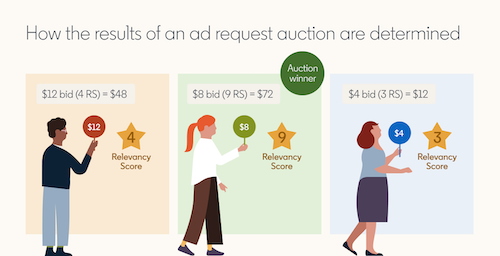LinkedIn shared a primer Monday on how the ads auction process works on its platform.
Product lead Crystal Shi said in a blog post that the auction process occurs hundreds of million of times daily, each time a member visits the professional network.
When an advertiser creates an ad, it also defines the target audience to let LinkedIn know who it is trying to reach.
Once the campaign is running, ads automatically enter the auction process, and which auctions they compete in are determined by those target audiences.
While members can fall into multiple target audiences—Shi gave the example of someone belonging to both “job title” software engineer” and “interest: MBA program”—when the opportunity arises to show a member an ad, all ads with the target audience that the members belong to are eligible to compete.
Shi said two main factors determine which ads appear and in what order.
- The bid: The amount an advertiser bids expresses how much that advertiser values the desired goal, and Shi noted that advertisers often wind up paying less than what they bid, and bids can be changed at any time.
- Relevancy: LinkedIn wants to ensure that members see content they are interested in and may engage with, so each update is assigned a relevance score that measures how engaging a given update is for the targeted audience. The relevance score for ads is based on predicted response rates, or how likely it is that a given member engages with or converts through that particular ad.
Shi wrote, “The ads that win auctions on LinkedIn are the ads that drive the most value to both members and advertisers. To win auctions and maximize your campaign’s success, your ads must have both a good relevancy score and an appropriate bid —and this combination determines who wins the auction and serves ads on our platform.”

When creating campaigns, advertisers specify the objective of the campaign, and LinkedIn’s objective-based advertising optimizes the bid based on that objective, such as engagement, impressions or video views. Ads pricing, bidding and ad delivery on the professional network are all aligned to the selected objective.
Manual bidding and target cost bid strategies enable advertisers to bid on a specific goal, such as video views or website visits, and they are only charged when that billable action occurs.
Advertisers are also charged the minimum of what they need to beat out the second-place bidder. Shi wrote, “If you bid $1.40 and beat an otherwise identical ad bidding $1, your campaign will be charged $1.01 if the person it was shown to makes the billable action.”
Shi also provided more color on bidding strategies, writing, “The auctions system indicates that the price you pay per billable action is not a fixed rate, and this is where your bid strategy comes into play. Bid strategies are our overall approach to spending budget and getting results. Your bid strategy choice tells us how to bid for you in ad auctions. The correct bidding strategy depends on your business needs. Our ads platform offers a number of bid strategies that are designed to maximize your particular cost strategy.”
Examples include:
- Maximum delivery: Designed to auto-optimize bids to produce the best results and the lowest cost. Shi said this is the best way for marketers to spend their budgets as efficiently as possible/
- Manual bidding: Advertisers can specify the maximum bid amount they are willing to pay, and the cost of the campaign will not exceed that amount.
- Target CPX bidding: Advertisers can achieve a stable average price per event over time by auto-optimizing their bids to achieve a daily average cost at or near that value.
https://www.adweek.com/programmatic/linkedin-provides-a-peek-at-the-inner-workings-of-its-ads-auction-process/

